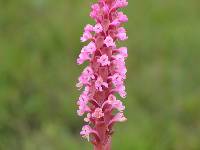
Herbs or rarely vines, perennial, rarely annual, strongly mycotrophic, epiphytic, terrestrial, lithophytic, or rarely aquatic or subterranean, usually green and photosynthetic, some without chlorophyll and saprophytic. Roots subterranean or aerial, tuberoid or stolonoid, usually with spongy, multilayered velamen. Stems erect or pendent or modified into creeping rhizomes, simple or sympodially or monopodially branched, delicate to stout, or thickened as corms or pseudobulbs, or greatly reduced, sometimes proliferous (especially diverse in sympodial orchids). Leaves solitary, several, or reduced to scales, basal or cauline, alternate, distichous, or sometimes opposite or whorled, either convolute or duplicate, simple, sessile or petiolate; stipules absent; blade articulate or not, plicate or conduplicate, cylindric, triangular, or laterally flattened, margins entire. Inflorescences terminal or lateral, racemes, spikes, panicles, or rarely cymose, erect or variously pendent, 1–many-flowered, lax or dense, flowering successively or simultaneously. Flowers bisexual [rarely unisexual], epigynous, resupinate or not, pedicellate or sessile, 3-merous, usually bilaterally symmetric [rarely nearly radially symmetric], with abscission layer between pedicel and peduncle, rarely between ovary and perianth or ovary and pedicel; perianth of 6 tepals in 2 whorls, all petaloid or sepals sometimes greener and more foliaceous in texture; sepals alike or not, lateral sepals often connate (forming synsepal), or all 3 sepals variously connate and/or adnate or distinct and/or free; petals 3, median petal modified as lip, commonly larger or differing in form and color, lateral petals commonly but not always similar to sepals; nectaries of various sorts; extrafloral nectaries sometimes present on pedicels, bracts, or leaf sheaths; stamens usually 1–2(–3, if 3 the 3d modified into sterile staminode), all on side opposite lip, fully or partially adnate to style, forming column; pollen grains in monads or tetrads, usually in 2–8 pollinia, sometimes subdivided into small packets, rarely granular, sometimes pollinia with caudicles and/or stipes; gynoecium 3-carpellate, connate, forming compound, inferior, 1- or 3-locular ovary; style variously adnate to filaments; stigmas usually 3-lobed, concave to convex, part of median stigma lobe modified into rostellum, often separating anther from fertile portions of stigma, commonly preventing or in some cases facilitating self-pollination; ovules numerous, anatropous, minute. Fruits capsules, opening (dehiscing) by longitudinal slits, rarely fleshy and indehiscent berries.
not available
not available
not available
not available
not available
Copyright (c)2020. Data portal development has been supported through the cooperation of Biocultural Diversity International and the National Herbarium of Rwanda (NHR)
at the Center of Excellence in Biodiversity and Natural Resources Management (CoEB).
We are currently actively seeking additional funding for this project.
Powered by Symbiota software with site management and data curation support by Michael B. Thomas, PhD. Usage Policy.










